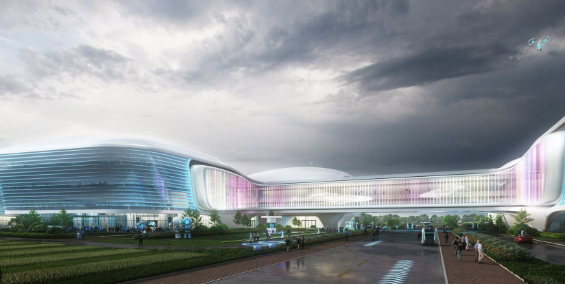A Closer Look at the Aedas Biopharma Complex by Aedas

Biopharma Complex by Aedas
Introduction
In the realm of architectural marvels, the Aedas Biopharma Complex stands out as a testament to the union of cutting-edge design and industry-specific functionality. Crafted by the renowned architectural firm Aedas, this structure mirrors the evolving demands of the biopharmaceutical sector. This article dives deep into the architectural nuances of this iconic complex and explores its significance in the contemporary design landscape.
Also Read:- Discovering the Majestic Underground Cities in The World
Futurist Architecture
Art movement, technology
Futurism came into being in the 1900s, all thanks to the Italian artist and poet – Flippo Tommaso Marinetti. Initially, it started as an art movement to oppose what was prevalent at that time and to break away from contemporary practices. Firstly, it can be seen in literature, sculptures, and paintings. Later, in big cities, architecture also adopted the theme. The word comes from the Latin word ‘futura’ or ‘futur’, which attempts to convey the ideas of past, present, and future. The aim of futurism is to make a rational and creative future in the name of humanity. One of the most significant features of futurist architecture is the movement and flow. Unlike prior forms of architecture, pointed edges, acute angles, curves, and asymmetry form the identity of the discipline. The structures of the buildings are generally inspired by nature.
The Vision Behind the Design
In creating the Biopharma Complex, Aedas aimed to merge the principles of modern architecture with the specific requirements of biopharmaceutical research and production. The design isn’t just aesthetic; it resonates with the mission and ethos of the biopharma industry, showcasing innovation, precision, and progressiveness.
Since the form of the buildings is not at 90 degrees and is completely unpredictable, architects and designers win with the help of technology. The role of technology spans from designing structures to creating new construction materials. It is because of technology that gravity can be overcome and skyscrapers could be built. The introduction of space exploration programs and aerodynamic studies also has an impact on futuristic buildings. The architecture is a blend of aesthetics and technology. Since it is modern and dynamic, a lot of use of metal and glass can be seen. Some famous examples of Futurist architecture are the Guggenheim Museum (Bilbao, Spain); Cybertecture Egg (Mumbai, India); Kunsthaus Graz (Graz, Austria); Futurescope (Poitiers, France); Galaxy Soho (Beijing, China), etc.
Some other features of futurist architecture are monochromatic colour themes and long dynamic lines.
In 1934, a manifesto on aerial architecture was published by Marinetti, Angiolo Mazzoni, and Mino Somenzi. This manifesto featured a factory placed in Lingotto, Turin. The building had the test track on the roof which was a new concept; breaking away from all rules, the factory was recognized as the first futurist architectural invention. In the 1980s, architecture started comprising computers which paved the way for computer programming and simulating design models. As a result, parametric architecture was born.
Aedas Biopharma Complex, Beijing
Name: SINOVAC High-Tech Achievements Transformation Project
Location: Beijing, China
Type: Office Commercial
Status: Under construction
Gross floor area: 120,000 sq. m.
Client: Beijing Zhongwei Yidao Biotechnology Co., Ltd
Global design principals: Ken Wai, Dr. Andy Wen, and Zihuan Lin
Sinovac biotech limited is a Beijing-based pharmaceutical company. Research, development, manufacture, and commercialisation of vaccines to protect humans from infectious diseases are the disciplines that the company deals with. For its headquarters to be in Changping Life Science Park Beijing, the company turned to Aedas, an international multidisciplinary architecture firm established in 2002. The construction for the headquarters started on September 28, 2022, and is continuing, making it one of the three most developed and evolved biotech zones in the city. The park is well-connected to the metro and the expressway.
Concept
Tree of life
As the company is based on making life-saving vaccines, the concept has been taken from the ‘Tree of Life.’
In total, there are seven towers. Two towers are on the South, representing the roots; one is on the North representing the crown of the tree. The remaining four towers are coming out of the stem-like corporate gallery, two each in the East and the West. The interconnected towers reflect one more concept – ‘to deliver health solutions by innovating pharmaceuticals through interconnected specialities.’ (architizer, 2022)
Design
Towers, Sunken Plaza
‘Adopting a simple design approach, [it] reveals a neat architectural form to create a futuristic aesthetic and grand corporate image,’ notes Aedas Global Design Principal Dr Andy Wen. (Designboom, 2022) The interiors are simple, without any corners or edges, merging into one another. The spaces consist of the Research and development cells in the South. The manufacturing unit is in the North. The straight long corridor has the corporate gallery and some public spaces. Elevated corridors find their place between the stem and side towers to facilitate the circulation and flow of logistics. In the North, there is a sunken plaza that is accessed via an entry from the South. This sunken plaza has some green natural elements that promote health while working and provide an aesthetic breathable space. This very plaza also houses the provision for eateries.
The Sinovac Biopharma complex has a seamless design. It has a single-color theme; bold, linear element in the center; and dynamic and curved form. It also has an impression that the structure above is heavy, supported by a lighter structure below, giving a sense of defying gravity. The use of glass and other modern materials can easily be seen. The roof also has an unconventional design with holes on the top. All these features make the design truly futuristic.







